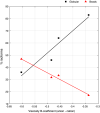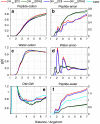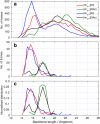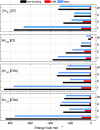Aqueous ionic liquids influence the disulfide bond isoform equilibrium in conotoxin AuIB: a consequence of the Hofmeister effect?
- PMID: 29294259
- PMCID: PMC5988620
- DOI: 10.1007/s12551-017-0391-2
Aqueous ionic liquids influence the disulfide bond isoform equilibrium in conotoxin AuIB: a consequence of the Hofmeister effect?
Abstract
The appearance of several disulfide bond isoforms in multiple cysteine containing venom peptides poses a significant challenge in their synthesis and purification under laboratory conditions. Recent experiments suggest that careful tuning of solvent and temperature conditions can propel the disulfide bond isoform equilibrium in favor of the most potent, native form. Certain aqueous ionic liquids (ILs) have proven significantly useful as solvents for this purpose, while exceptions have also been noted. To elucidate the molecular level origin behind such a preference, we report a detailed explicit solvent replica exchange molecular dynamics study of a conotoxin, AuIB, in pure water and four different aqueous IL solutions (~45-60% v/v). The ILs studied here are comprised of cations like 1-ethyl-3-methyl-imidazolium (Im21+) or 1-butyl-3-methyl-imidazolium (Im41+) coupled with either acetate (OAc-) or chloride (Cl-) as the counter anion. Our simulations unfold interesting features of the conformational spaces sampled by the peptide and its solvation in pure water and aqueous IL solutions. Detailed investigation into populations of the globular disulfide bond isoform of AuIB in aqueous IL solutions reveal distinct trends which might be related to the Hofmeister effect of the cation and anion of the IL and of specific interactions of the aqueous IL solutions with the peptide. In accordance with experimental observations, the aqueous [Im21][OAc] solution is found to promote the highest globular isoform population in AuIB.
Keywords: Conopeptide; Disulfide scrambling; Hofmeister effect; Ionic liquid; REMD.
Conflict of interest statement
Karuna Anna Sajeevan declares that she has no conflict of interest. Durba Roy declares that she has no conflict of interest.
Figures








Similar articles
-
Peptide Sequence and Solvent as Levers to Control Disulfide Connectivity in Multiple Cysteine Containing Venom Toxins.J Phys Chem B. 2018 Jun 7;122(22):5776-5789. doi: 10.1021/acs.jpcb.8b01437. Epub 2018 May 24. J Phys Chem B. 2018. PMID: 29757637
-
Temperature-dependent molecular dynamics study reveals an ionic liquid induced 310 - to α-helical switch in a neurotoxin.Biopolymers. 2017 May;108(3). doi: 10.1002/bip.23009. Biopolymers. 2017. PMID: 28009043
-
Scrambling of disulfide bond scaffolds in neurotoxin AuIB: A molecular dynamics simulation study.Biopolymers. 2016 Mar;106(2):196-209. doi: 10.1002/bip.22799. Biopolymers. 2016. PMID: 26714232
-
Hofmeister effects: an explanation for the impact of ionic liquids on biocatalysis.J Biotechnol. 2009 Oct 12;144(1):12-22. doi: 10.1016/j.jbiotec.2009.04.011. Epub 2009 May 4. J Biotechnol. 2009. PMID: 19409939 Review.
-
NHC in Imidazolium Acetate Ionic Liquids: Actual or Potential Presence?Front Chem. 2018 Aug 28;6:355. doi: 10.3389/fchem.2018.00355. eCollection 2018. Front Chem. 2018. PMID: 30211149 Free PMC article. Review.
Cited by
-
Inferring Pathways of Oxidative Folding from Prefolding Free Energy Landscapes of Disulfide-Rich Toxins.J Phys Chem B. 2023 Mar 2;127(8):1689-1703. doi: 10.1021/acs.jpcb.2c07124. Epub 2023 Feb 15. J Phys Chem B. 2023. PMID: 36791259 Free PMC article.
-
Snails In Silico: A Review of Computational Studies on the Conopeptides.Mar Drugs. 2019 Mar 1;17(3):145. doi: 10.3390/md17030145. Mar Drugs. 2019. PMID: 30832207 Free PMC article. Review.
References
-
- Abraham MJ, Gready JE (2008) Ensuring mixing efficiency of replica-exchange molecular dynamics simulations. J Chem Theory Comput 4(7):1119–1128 - PubMed
-
- Benedetto A, Ballone P (2016a) Room temperature ionic liquids meet biomolecules: a microscopic view of structure and dynamics. ACS Sustain Chem Eng 4(2):392–412
-
- Benedetto A, Ballone P (2016b) Room temperature ionic liquids interacting with bio-molecules: an overview of experimental and computational studies. Philos Mag 96(7–9):870–894
Publication types
Grants and funding
LinkOut - more resources
Full Text Sources
Other Literature Sources

